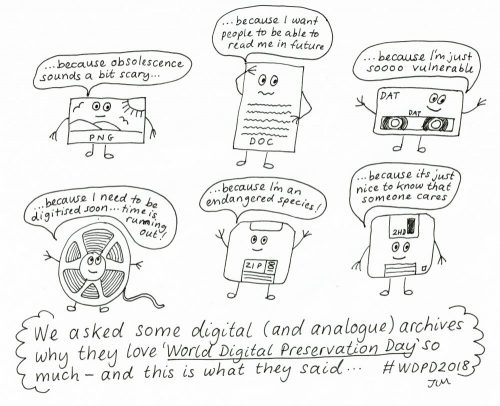This article is more than 5 years old.
There isn’t a Hallmark card for the occasion just yet, but today marks the annual World Digital Preservation Day. Initiated by the Digital Preservation Coalition, the organizers want to inspire archivists, historians, and the general public to help ensure that future generations can find and use our most important digital content.
It can be difficult to get a sense of the overwhelming amount of data we now create on a daily basis, with no slowdown in sight. Almost 90% of the world’s existing digital data was generated in the last two years, and, according to the recent Data Never Sleeps report, an immense amount of data travels the globe every minute of the day. (1) For example, on social media:
- Snapchat users share 527,760 photos
- Users watch 4,146,600 YouTube videos
- 456,000 tweets are sent on Twitter
- Instagram users post 46,740 photos
Unfortunately, there is no guarantee that any of the digital content we’re creating now will be around in 10, 20, or 50 years. This uncertainty has significant implications for preserving cultural memory. How will our grandchildren know what our lives were like? When we gather to tell stories and relive old memories, will we be able to access the thousands of photos and videos on our phones, tablets, laptops, and desktops? A hundred years from now, will our organizations, libraries, and universities be able to plan centennial celebrations using digital images created today?

Given the challenges of preserving digital content, much of our digital heritage seems likely to be lost for good. Digital media are more susceptible to loss than the books and papers resting on shelves and in filing cabinets; as digital curation scholar Dr. Helen Tibbo argues, digital objects cannot withstand “benign neglect.” File format obsolescence or corruption, lack of context, and the inability to find hardware to run legacy software are common problems facing digital archivists and historians.
Internet “evangelist” Vint Cerf, a VP at Google, has publicly worried about the future of our digital memories, arguing that we are close to experiencing a “digital dark age.” Says Cerf: “Old formats of documents that we’ve created or presentations may not be readable by the latest version of the software because backwards compatibility is not always guaranteed. And so what can happen over time is that even if we accumulate vast archives of digital content, we may not actually know what it is.” (2)
On World Digital Preservation Day, the DPC hopes you will take a moment to think about your own digital possessions. Which content would you most regret losing? Which photos, videos, and documents do you most treasure? If you are a researcher or an artist, which digital files represent your most important work? To help reduce risks to your most important digital media, it’s helpful to create a digital preservation action plan that follows guidelines such as the 3-2-1 rule: 3 copies of a digital file, stored on 2 types of storage devices, with 1 copy held off-site (cloud storage counts as “off-site”). In addition, print a list of the digital storage locations you use, along with essential passwords, and keep it in a safe place. This information can be shared with close family members or friends if you are incapacitated. There are even formal digital estate planning services to help ensure your digital files persist beyond your lifetime.
If you are a researcher, be sure that your completed papers and underlying data have a permanent home in a digital repository. (The DISC team at ZSR can help you locate an appropriate repository – for example, WakeSpace – and support you in planning for future digital projects.)
Stop by and chat with DISC about your digital preservation questions!
Notes
1: As quoted in Forbes Magazine, How Much Data Do We Create Every Day? The Mind-Blowing Stats Everyone Should Read
2. BBC News, Google’s Vint Cerf warns of ‘digital Dark Age’
3. Cartoon image copyright Jenny Mitcham via Twitter, 11/29/2018

3 Comments on ‘World Digital Preservation Day’
Heather, this is great! I’m going to use the 3-2-1 rule when I talk with people about preserving their data! Thanks for this great post!
This is really frightening stuff. My physical documents are in enough of a disarray, but at least the are findable. My digital stuff is everywhere. I need to pause and get a handle on it. Maybe “World Preservation Day” should be devoted to giving everyone a chance to start getting all of their digital documents cleaned up, backed up, and documented! Thanks for sharing!
Thanks for sharing the 3-2-1 plan, Heather. I know it, but the reminder to revisit periodically is helpful! And I think you should start working on that Hallmark card… 😉